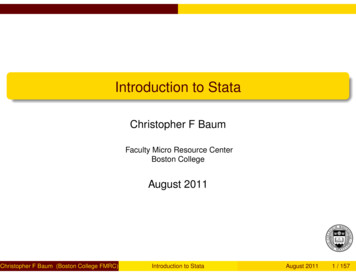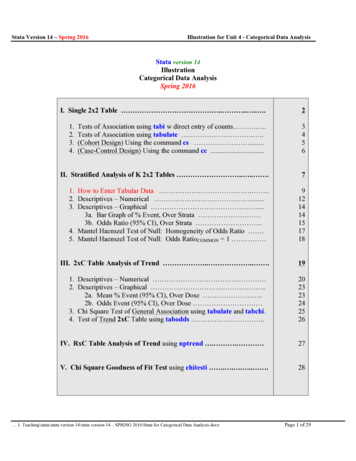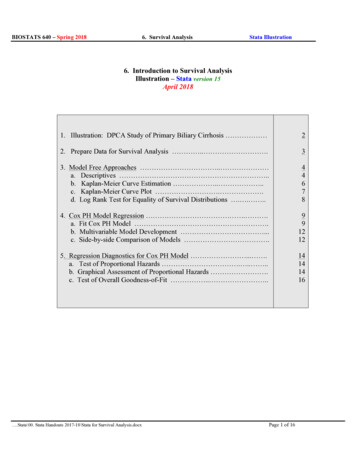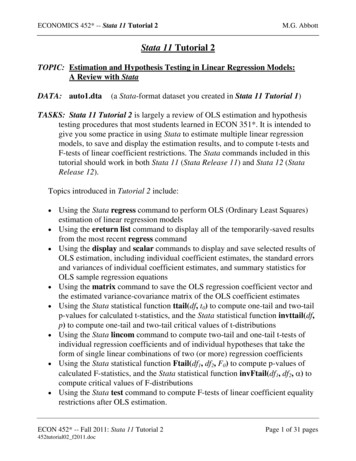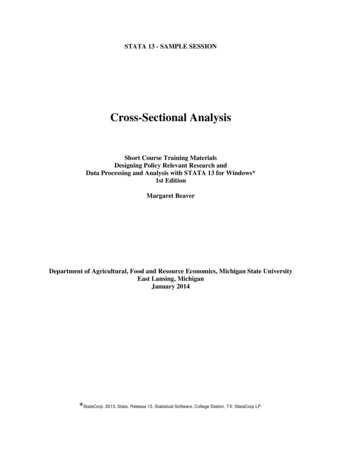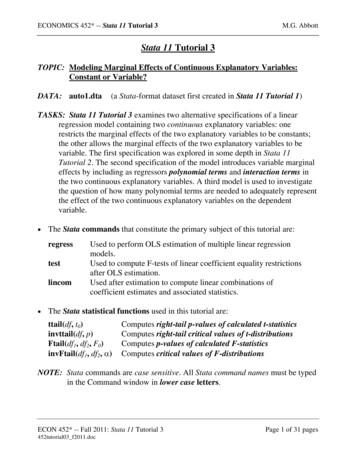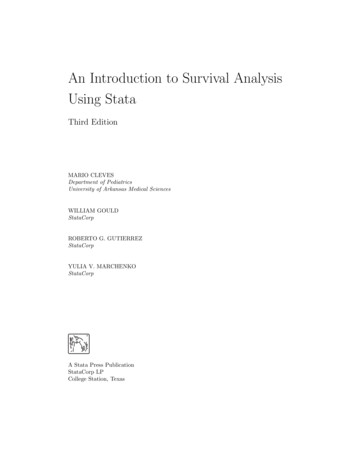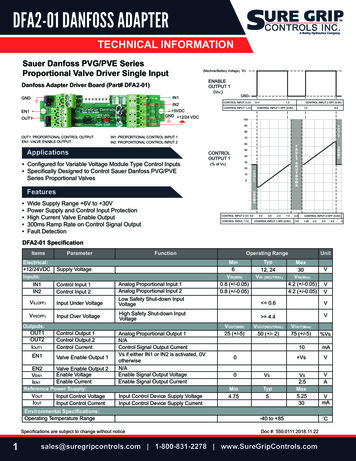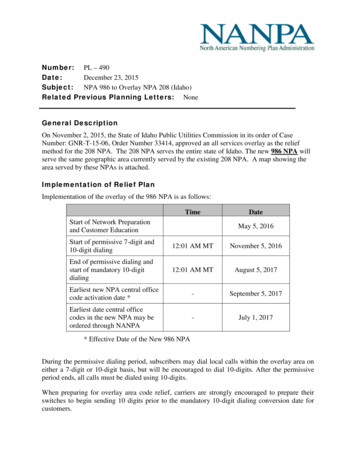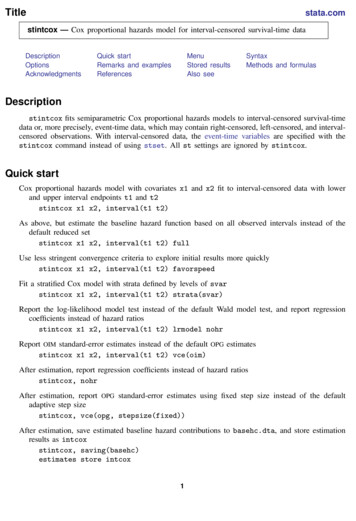
Transcription
Titlestata.comstintcox — Cox proportional hazards model for interval-censored survival-time dataDescriptionOptionsAcknowledgmentsQuick startRemarks and examplesReferencesMenuStored resultsAlso seeSyntaxMethods and formulasDescriptionstintcox fits semiparametric Cox proportional hazards models to interval-censored survival-timedata or, more precisely, event-time data, which may contain right-censored, left-censored, and intervalcensored observations. With interval-censored data, the event-time variables are specified with thestintcox command instead of using stset. All st settings are ignored by stintcox.Quick startCox proportional hazards model with covariates x1 and x2 fit to interval-censored data with lowerand upper interval endpoints t1 and t2stintcox x1 x2, interval(t1 t2)As above, but estimate the baseline hazard function based on all observed intervals instead of thedefault reduced setstintcox x1 x2, interval(t1 t2) fullUse less stringent convergence criteria to explore initial results more quicklystintcox x1 x2, interval(t1 t2) favorspeedFit a stratified Cox model with strata defined by levels of svarstintcox x1 x2, interval(t1 t2) strata(svar)Report the log-likelihood model test instead of the default Wald model test, and report regressioncoefficients instead of hazard ratiosstintcox x1 x2, interval(t1 t2) lrmodel nohrReport OIM standard-error estimates instead of the default OPG estimatesstintcox x1 x2, interval(t1 t2) vce(oim)After estimation, report regression coefficients instead of hazard ratiosstintcox, nohrAfter estimation, report OPG standard-error estimates using fixed step size instead of the defaultadaptive step sizestintcox, vce(opg, stepsize(fixed))After estimation, save estimated baseline hazard contributions to basehc.dta, and store estimationresults as intcoxstintcox, saving(basehc)estimates store intcox1
2stintcox — Cox proportional hazards model for interval-censored survival-time dataMenuStatistics Survival analysis Regression models Interval-censored Cox PH modelSyntaxstintcox indepvarsoptionsModel interval(tl tu )reducedfullstrata(varlist)favoraccuracyfavorspeed if in , interval(tl tu ) optionsDescriptionspecify lower and upper endpoints for the event-time intervalestimate baseline hazard function using a reduced set of timeintervals; the defaultestimate baseline hazard function using all time intervalsspecify strata variablesfavor accuracy of results over speed; the defaultfavor speed possibly over accuracy of resultsSEvce(vcetype)vcetype may be opg or oim; may be specified on replay ofresults; default is opgReportingset confidence level; default is level(95)perform the likelihood-ratio model test instead of the defaultWald model test saving( filename , replace ) save estimates of baseline hazard contributions to filename;use replace to overwrite existing filenamenohrreport regression coefficients, not hazard ratiosnoheadersuppress header from coefficient table no logdisplay or suppress EM and VCE iteration logs; default is log no dotsdisplay all EM and VCE iterations as dots or suppress bothdisplay optionscontrol columns and column formats, row spacing, line width,display of omitted variables and base and empty cells, andfactor-variable labelinglevel(#)lrmodelEM hsgtolerance(#)noemhsgtolerancefrom(init specs)maximum number of EM iterations; default isemiterate(5000)tolerance for the coefficient vector; default isemtolerance(1e-6)tolerance for the log likelihood; default is emltolerance(1e-7)tolerance for the scaled gradient; default isemhsgtolerance(1e-5)do not perform the scale-gradient convergence checkinitial values for the regression coefficients
stintcox — Cox proportional hazards model for interval-censored survival-time data no emlog (#) no emdots (#)coeflegend3display or suppress EM iteration log; default is emlog(100),which displays the log-likelihood value every 100 iterationsdisplay or suppress EM iteration dots; default is noemdotsdisplay legend instead of statistics interval(tl tu ) is required.varlist may contain factor variables; see [U] 11.4.3 Factor variables.by, collect, and statsby are allowed; see [U] 11.1.10 Prefix commands.coeflegend does not appear in the dialog box.See [U] 20 Estimation and postestimation commands for more capabilities of estimation commands.vcetypeDescriptionSE opg , vce options oim , vce optionsouter product of the gradient (OPG) vectors; the defaultvce optionsDescriptionobserved information matrix (OIM)SE stepsize(adaptive fixed # ) use adaptive or fixed step size to compute VCE;default is adaptive step sizederivoptsoptions to control computation of numerical derivativeswhen adaptive step size is usediterate(#)maximum number of iterations to compute VCE;default is iterate(5000)tolerance(#)profile log-likelihood tolerance to compute VCE;default is tolerance(1e-6) no vcedots (#)display or suppress VCE iteration dots; default is to display adot every iteration, meaning vcedots or vcedots(1) no dots (#)synonym for vcedots, vcedots(), and novcedotspostreplace the current e(V) with the specified VCE type;can be used only on replay with opg or oimdots, dots(), nodots, and post do not appear in the dialog box.Options Modelinterval(tl tu ) specifies two time variables that contain the endpoints of the event-time interval.tl represents the lower endpoint, and tu represents the upper endpoint. interval() is required.
4stintcox — Cox proportional hazards model for interval-censored survival-time dataThe interval time variables tl and tu should have the following form:Type of soredright-censoredmissingmissing( a, b ]( 0, b ]( 0, b ]( a, )tltua.0a.0bbb.Note that tl tu is not allowed with left-censored or interval-censored observations.reduced, the default, specifies that the baseline hazard function be estimated using a reduced(innermost) set of time intervals. This allows the estimator of the cumulative baseline hazardfunction to change its values only at the endpoints of the innermost time intervals, which wereoriginally used by Turnbull (1976) to estimate the survivor function in the one-sample case. Thisoption may not be combined with full.full specifies that the baseline hazard function be estimated using all observed time intervals. In thiscase, the estimator of the cumulative baseline hazard function can potentially change its valuesat the endpoints of all the observed time intervals. This is the approach used by Zeng, Mao, andLin (2016). It is more time consuming, but it may provide more accurate results. full may notbe combined with reduced.strata(varlist) specifies the stratification variables. Observations with equal values of the stratavariables are assumed to be in the same stratum. Stratified estimates (equal regression coefficientsacross strata but with a baseline hazard unique to each stratum) are then obtained.favoraccuracy, the default, and favorspeed control the tradeoff between accuracy of the resultsand the execution speed. favoraccuracy specifies that the command run longer to obtain moreaccurate results. favorspeed specifies that the command run faster at the possible expense ofreduced accuracy of the results. You can use favorspeed for a quick initial exploration of theresults and favoraccuracy for final reporting of the results.When you specify favorspeed, stintcox uses less stringent convergence criteria to obtain theresults. Specifically, it assumes lower EM coefficient, likelihood, and VCE tolerances of 0.0001and implies option noemhsgtolerance. In addition, it uses a fixed step size with a multiplierof 5 instead of an adaptive step size when computing VCE. That is, specifying favorspeed isequivalent to specifying emtolerance(0.0001), emltolerance(0.0001), noemhsgtolerance,and vce(, tolerance(0.0001) stepsize(fixed)). SEvce(vcetype) specifies the type of standard error estimate reported. vce() may be specified at thetime of estimation or when replaying results. vcetype may be one of the following: vce(opg , vce options ) uses the sum of the outer product of the gradient (OPG) vectors basedon the profile log likelihood; see Methods and formulas. vce(opg) is the default. vce(oim , vce options ) uses the sum of the observed information matrix (OIM) vectors basedon the profile log likelihood; see Methods and formulas.vce options include stepsize(), derivopts with adaptive step size, iterate(#), tolerance(#),dots, dots(), nodots, and post. These options are available only with vce(opg) and vce(oim).
stintcox — Cox proportional hazards model for interval-censored survival-time data5 stepsize(adaptive fixed # ) specifies the step size for computing numerical derivativeswith methods opg and oim. The default is stepsize(adaptive), which uses adaptive stepsize in computations; see [M-5] deriv( ). stepsize(fixed) uses a fixed step size equal toδn 5n 1/2 . stepsize(fixed #) uses a fixed step size equal to # n 1/2 .derivopts are allowed only with stepsize(adaptive) and include search(), h(), scale(),and bounds().search(search type) specifies the approach used to search for an optimal step sizefor computing the numerical derivatives; three approaches are offered: bracket,interpolate, and off; see deriv init search() in [M-5] deriv( ). The defaultis search(interpolate). In some cases, such as when factor variables have highlyunbalanced levels, the search may lead to the step size that is too small or too large, whichmay lead to the error message that the estimates of baseline hazard contributions cannot becomputed because the VCE matrix is close to being singular. Trying search(bracket)may be helpful in this case.h(# matname) specifies the h values, which are multipliers for step size used to computenumerical derivatives; see deriv init h() in [M-5] deriv( ). You can specify the sameh value, #, for all parameters or parameter-specific h values as a Stata matrix (vector)matname.scale(# matname) specifies the starting scale values used to compute numerical derivatives;see deriv init scale() in [M-5] deriv( ). You can specify the same initial scale value,#, for all parameters or parameter-specific initial scale values as a Stata matrix (vector)matname.bounds(# 1 # 2 ) specifies the minimum and maximum values used to search for optimalscale values; see deriv init bounds() in [M-5] deriv( ). The default is bounds(1e-61e-5).iterate(#) specifies the maximum number of iterations to compute the VCE based on theprofile log likelihood. The default is iterate(5000).tolerance(#) specifies the tolerance for the profile log likelihood used to compute the VCE.The default is tolerance(1e-6).vcedots, vcedots(#), and novcedots display or suppress iteration dots showing the progressof the variance estimation. The dots are displayed by default, but you can use novcedotsto suppress them. By default, the dot is displayed every iteration, but you can change thisby specifying vcedots(#).When a fixed step size is used, an iteration corresponds to one derivative computationwith respect to a regression coefficient. When an adaptive step size is used, an iterationcorresponds to one call of the Mata deriv() function, which may be called multiple timesto compute one derivative with respect to one regression coefficient. Thus, you will typicallysee more iteration dots with VCE estimation using an adaptive step size than using a fixedstep size.dots, dots(#), and nodots are synonyms for vcedots, vcedots(#), and novcedots,respectively. These options do not appear in the dialog box.post can be used only on replay with vce(opg) or vce(oim). It replaces the current e(V)with the specified vcetype. When vce(opg) or vce(oim) is used on replay without post,the coefficient table will display the standard error of the specified vcetype, but e(V) willremain unchanged. This option does not appear in the dialog box.
6 stintcox — Cox proportional hazards model for interval-censored survival-time data Reportinglevel(#), lrmodel; see [R] Estimation options. saving(filename , replace ) saves the estimated baseline hazard contributions in filename.dta.The replace option specifies to overwrite filename.dta if it exists. If option saving() is notspecified, stintcox saves estimation results in a temporary file for later access by postestimationcommands. This temporary file will be overridden every time stintcox is run and will also beerased if the current estimation results are cleared. saving() may be specified during estimationor on replay.Because the file containing the baseline hazard contributions is considered to be part of estimationresults, you must use option saving() before storing or saving your estimation results usingestimates store or estimates save.nohr specifies that regression coefficients be displayed rather than exponentiated regression coefficientsor hazard ratios. This option affects only how results are displayed and not how they are estimated.nohr may be specified at estimation time or when replaying results.noheader suppresses the output header, either at estimation or upon replay.log and nolog are synonyms for emlog and vcedots and for noemlog and novcedots, respectively.The default is log. If log or nolog is specified, any other option that controls an iteration log isignored. log and nolog may not be combined with dots and nodots.nodots and dots are synonyms for noemdots and novcedots and for emdots and vcedots,respectively. The default is emlog and vcedots. If dots or nodots is specified, any other optionthat controls an iteration log is ignored. dots and nodots may not be combined with log andnolog.display options: noci, nopvalues, noomitted, vsquish, noemptycells, baselevels,allbaselevels, nofvlabel, fvwrap(#), fvwrapon(style), cformat(% fmt), pformat(% fmt),sformat(% fmt), and nolstretch; see [R] Estimation options. EM optionsemiterate(#), emtolerance(#), emltolerance(#), emhsgtolerance(#), noemhsgtolerance, and from(); see iterate(), tolerance(), ltolerance(), nrtolerance(), nonrtolerance, and from() in [R] Maximize. These options control the EM optimization process. The defaults are emiterate(5000), emtolerance(1e-6), emltolerance(1e-7), andemhsgtolerance(1e-5).emlog, emlog(#), and noemlog display or suppress an iteration log showing the progress of the EMalgorithm. The log is displayed by default, and noemlog suppresses it; see set iterlog in [R] setiter. emlog, the default, displays the log-likelihood value every 100 iterations and is equivalent toemlog(100). emlog(#) displays the log-likelihood value every #th iterations.noemdots, emdots(#), and emdots control the display of the EM iteration log as dots. By default,the EM iteration log displays the log-likelihood value every 100 iterations; that is, noemdots isimplied. Instead, you can specify emdots to display every 100 iterations as a dot or emdots(#)to display every # iterations as a dot. This is a useful alternative for long EM iteration logs.The following option is available with stintcox but is not shown in the dialog box:coeflegend; see [R] Estimation options.
stintcox — Cox proportional hazards model for interval-censored survival-time dataRemarks and examples7stata.comRemarks are presented under the following headings:IntroductionCase II interval-censored dataStandard-error estimation with interval-censored dataCurrent status or case I interval-censored dataIntroductionstintcox fits the Cox proportional hazards model to interval-censored survival-time data. In thecontext of interval-censored data, the term “failure-time data” or, more generally, “event-time data”is more appropriate, so we will use it in that context.Interval-censoring occurs when the failure time or, more generally, the event time of interest is notexactly observed but is known only to lie within some interval. See Introduction in [ST] stintreg fordetails about interval-censored data. If you have right-censored data, see [ST] stcox. See [ST] stintregfor fitting parametric models to interval-censored data.The Cox proportional hazards model was first introduced by Cox (1972) for right-censoredsurvival data. For an introduction to interval-censored data, see Finkelstein and Wolfe (1985), Odell,Anderson, and D’Agostino (1992), Rabinowitz, Tsiatis, and Aragon (1995), Huang and Wellner (1997),Lindsey (1998), Lindsey and Ryan (1998), Sun (2006), and Sun and Li (2014).The Cox proportional hazards model specifies that the hazard function of the event time conditionalon covariates takes the formh(t; x) h0 (t) exp(β1 x1 · · · βp xp )where β1 , . . . , βp are unknown regression coefficients, x are p-vector time-independent covariates,and h0 (t) is an arbitrary baseline hazard function. Under the proportional-hazards assumption, thehazard ratios, or exponentiated regression coefficients exp(β1 ), . . . , exp(βp ), are constant over time.As with right-censored data, the Cox proportional hazards model is appealing for interval-censoreddata because it does not require parameterization of the baseline hazard function and, for low eventrates, the exponentiated regression parameters approximate the log relative risks.The partial-likelihood approach (Cox 1972, 1975) is used to estimate parameters of the Cox modelwith right-censored data, in which some of the event times are observed exactly while others areknown to be longer than the duration of follow-up. Under interval-censoring, however, none of theevent times are observed exactly. Thus, it is much more challenging to deal with interval-censoreddata than right-censored data, both theoretically and computationally. In particular, the traditionalpartial-likelihood approach is not applicable.Several authors (Cai and Betensky 2003; Zhang, Hua, and Huang 2010; Wang et al. 2016) haveproposed spline methods to fit the Cox proportional hazards model to interval-censored data. Splinemethods have limitations, however. First, the choices for the type of spline and the number and positionsof knots are arbitrary, and different choices may yield conflicting results. Second, the analysis will bebiased if the event-time distribution is not well approximated by the chosen spline function. Finally,the variance estimation is difficult given the data-dependent choices of spline functions (Zhang, Hua,and Huang 2010).Direct maximum-likelihood optimization for the Cox model with interval-censored data using, forinstance, the Newton–Raphson algorithm is highly unstable (Sun 2006; Finkelstein 1986).
8stintcox — Cox proportional hazards model for interval-censored survival-time dataZeng, Mao, and Lin (2016) developed a novel EM algorithm for efficient nonparametric maximumlikelihood estimation (NPMLE) of the Cox proportional hazards model with interval-censored data. Itallows a completely arbitrary event-time distribution and results in consistent, asymptotically normal,and asymptotically efficient estimators of the regression parameters. And it reduces to the classicalmaximum partial-likelihood estimation in the special case of right-censored data. For more detailsabout this method, see Methods and formulas.Unlike with right-censored data, the estimation of regression coefficients must be performed jointlywith estimation of the baseline cumulative hazard function for interval-censored data. Stata providestwo ways to estimate the baseline cumulative hazard function. One is to use all distinct lower andupper interval endpoints as time points for estimating the baseline cumulative hazard function. Thisis available by specifying the full option.For large datasets with many distinct time points, this approach may become time consuming.An alternative is to estimate the baseline cumulative hazard at fewer time points. Turnbull (1976)proposed a method for estimating the one-sample survivor function at a subset of time intervals,known as Turnbull’s intervals, or innermost intervals, or regions of the maximal cliques. Thus, onecan allow the baseline cumulative hazard function to change its values only at the endpoints of thosetime intervals and set baseline hazard contributions to zero for the other times. This is available viathe reduced option and, for computational reasons, is the default in stintcox.As mentioned above, NPMLE is a computationally intensive approach, so stintcox may takesome time to run, especially for large datasets. The speed of the command depends on the desiredaccuracy of the computations, among other things. The higher the accuracy, the more iterations areneeded to achieve that accuracy, and thus the longer the command runs. It is important to havehigh accuracy for the final reporting of the results, but the speed may become an issue during theexploratory stage of the project. Thus, you may consider using the favorspeed option to expeditethe command execution. When you specify this option, stintcox uses less stringent convergencecriteria to produce the results more quickly; see description of option favorspeed for details.Just like stintreg, stintcox requires the outcome to be stored in the dataset as interval data.That is, two time variables, tl and tu , that contain the endpoints of the event-time interval must bespecified in the interval() option. If the data are left-censored, the lower endpoint is zero and maybe represented in tl by either a missing value (.) or zero. If the data are right-censored, the upperendpoint is and is represented in tu by a missing value. Uncensored data are represented bythe two endpoints that are equal. If 0 tl tu , the data are interval-censored. Truly missingvalues must be represented by missing values in both tl and tu or by a 0 in tl and a missing value intu . Typing stset ([ST] stset) is unnecessary, and stintcox will ignore any settings of stset forthe usual trivariate response variable (t0 , t, d). stintcox does not support data exhibiting delayedentry, gaps, time-varying covariates, and multiple failures.Case II interval-censored dataCase II interval-censored data arise when there are potentially two or more examination times foreach study subject. In this case, the interval that brackets the event time of interest, the event-timeinterval, is recorded for each subject. The event of interest may occur before the first examination time,resulting in a left-censored observation; after the last examination time, resulting in a right-censoredobservation; or between two examination times, resulting in a truly interval-censored observation.Example 1: Case II interval-censoringZeng, Mao, and Lin (2016) considered a cohort study of injecting drug users in Thailand.Subjects were initially seronegative for the HIV-1 virus. They were followed and assessed for HIV-1
stintcox — Cox proportional hazards model for interval-censored survival-time data9seropositivity through blood tests approximately every four months. The event of interest was timeto HIV-1 seropositivity. Because the subjects were tested approximately every four months, the exacttime of HIV-1 seropositivity was not observed and was known to fall only in the interval betweenblood tests.The data used in this example are the data provided in supplementary materials of Zeng, Mao,and Lin (2016), which are based on the study described above. The dataset contains 1,124 subjects:76 are females and 1,048 are males. We wish to identify the factors that influence HIV-1 infection.The covariates that we are interested in are age at recruitment (age), sex (male), history of needlesharing (needle), history of drug injection before recruitment (inject), and whether a subject hasbeen in jail at the time of recruitment (jail). The dataset also contains two variables, ltime andrtime, that record the last time of blood test when the HIV-1 was seronegative and the first time ofblood test when the HIV-1 was seropositive. use https://www.stata-press.com/data/r17/idu(Modified Bangkok IDU Preparatory Study). describeContains data from ations:1,124Modified Bangkok IDU PreparatoryStudyVariables:815 Dec 2020 13:34( dta has eage .0g%10.0gValuelabelyesnoyesnoyesnoyesnoVariable labelAge (in years)MaleShared needlesImprisonedInjected drugs before recruitmentLast time seronegative for HIV-1First time seropositive for HIV-1Centered age (in years)Sorted by:We want to use stintcox to fit a Cox proportional hazards model in which the time to HIV-1infection depends on age, male, needle, inject, and jail. To make the interpretation of the baselinehazard function more reasonable, we will use the centered age variable, age mean. (Remember thata baseline hazard function corresponds to all covariates equal to zero, and age of zero would notmake sense for our sample of subjects. See Making baseline reasonable in [ST] stcox postestimationfor more details.)Unlike stcox’s specification, in which the survival variables are set using stset and do notappear in the command, the interval time variables ltime and rtime must be specified in thestintcox’s option interval(). Also, recall that the command implements an NPMLE method,which is computationally intensive, so it may take a little longer to run on our dataset of 1,124observations:. stintcox age mean i.male i.needle i.inject i.jail, interval(ltime rtime)note: using adaptive step size to compute derivatives.Performing EM optimization (showing every 100 iterations):Iteration 0:log likelihood -1086.2564Iteration 100: log likelihood -597.65634Iteration 200: log likelihood -597.57555Iteration 295: log likelihood -597.56443Computing standard errors: . done
10stintcox — Cox proportional hazards model for interval-censored survival-time dataInterval-censored Cox regressionBaseline hazard: Reduced intervalsNumber of ens.Wald chi2(5)Prob chi2Log likelihood -597.56443Haz. ratioOPGstd. err.z 1,124 0 41 991 92 17.10 0.0043P z [95% conf. interval]age es1.567244.34739722.030.0431.0149822.419998Note: Standard-error estimates may be more variable for small datasets anddatasets with low proportions of interval-censored observations.The header above the coefficient table summarizes censored observations. There are 991 subjects whodid not test positive for HIV-1 by the last visit, resulting in right-censored observations. There are 41subjects who tested positive for HIV-1 at their first follow-up, resulting in left-censored observations.The remaining 92 subjects are interval-censored.The coefficient table shows that age is significantly associated with lower risk of HIV-1 infection andthere is some evidence that being in jail at enrollment is associated with higher risk of HIV-1 infection.Being a female, needle sharing, and history of drug injection are associated with the higher riskof HIV-1 infection, although without statistical significant evidence. Our findings are consistent withthose in Zeng, Mao, and Lin (2016), although they used a time-varying covariate for imprisonment.The command displays a note following the command that an adaptive step size is used to computederivatives during VCE computation. The command also displays a note following the output tableabout potential variability of the standard error estimates. We address all of this in more detail inStandard-error estimation with interval-censored data.stintcox uses the EM algorithm to estimate parameters. EM algorithms are known to requiremany iterations. Thus, by default, stintcox displays log-likelihood values every 100 iterations. Youcan change how often to display the iteration log by specifying the emlog(#) option. For example,emlog(1) will display every iteration. You can also use the noemlog option to suppress the iterationlog.Similarly, the progress of the VCE computation is displayed with a dot for each iteration. Withmore regression coefficients and with larger datasets, you may see many more dots. In this case, youmay consider displaying a dot every # iterations by specifying vcedots(#). To suppress the dots,use novcedots.
stintcox — Cox proportional hazards model for interval-censored survival-time data11Example 2: Speed versus accuracyBy default, stintcox uses Stata’s standard convergence rules for estimation of parameters. Forinstance, the parameter tolerance of 1e–6 is used as a stopping rule, and the Hessian scale-gradienttolerance of 1e–5 is used to check for convergence. More stringent criteria typically require moreiterations and thus lead to longer execution times.Although high accuracy of the results is important for final reporting, it may be reasonable toconsider less stringent criteria during exploratory analysis in favor of speed. stintcox provides thefavorspeed option for this. stintcox age mean i.male i.needle i.inject i.jail, interval(ltime rtime) favorspeednote: using fixed step size with a multiplier of 5 to compute derivatives.note: using EM and VCE tolerances of 0.0001.note: option noemhsgtolerance assumed.Performing EM optimization (showing every 100 iterations):Iteration 0:log likelihood -1086.2564Iteration 32:log likelihood -598.60293Computing standard errors: . doneInterval-censored Cox regressionBaseline hazard: Reduced intervalsLog likelihood -598.60293Haz. ratioOPGstd. err.zNumber of ens. 1,12404199192Wald chi2(5)Prob chi2 16.95 0.0046P z [95% conf. interval]age s1.251637.24145831.160.245.85757071.826784jailYes
4stintcox— Cox proportional hazards model for interval-censored survival-time data The interval time variables t l and t u should have the following form: Type of observations t l t u interval-censored (a;b] a b left-censored (0;b] . b left-censored (0;b] 0 b right-censored (a; 1) a . missing : : missing 0 : Note that t l t
